How to Improve
Your Flexibility
Stretching
exercises give you more freedom of movement to do the
things you need to do and the things you like to do. Stretching
exercises alone can improve your flexibility, but they
will not improve your endurance or strength.
How
Much, How Often?
- Stretch
after you do your regularly scheduled strength and endurance
exercises.
- If
you can't do endurance or strength exercises for some
reason, and stretching exercises are the only kind you
are able to do, do them at least 3 times a week, for
at least 20 minutes each session.
- Do
each stretching exercise 3 to 5 times
at each session.
- Slowly
stretch into the desired position, as far as possible
without pain, and hold the stretch for 10 to
30 seconds. Relax, then repeat, trying to stretch
farther.
Safety
- If
you have had a hip replacement, check with your surgeon
before doing lower body exercises.
- If
you have had a hip replacement, don't cross your legs
or bend your hips past a 90-degree angle.
- Always
warm up before stretching exercises (do them after endurance
or strength exercises, for example; or, if you are doing
only stretching exercises on a particular day, do a
little bit of easy walking and arm-pumping first). Stretching
your muscles before they are warmed up may result in
injury.
- Stretching
should never cause pain, especially joint pain. If it
does, you are stretching too far, and you need to reduce
the stretch so that it doesn't hurt.
- Mild
discomfort or a mild pulling sensation is normal.
- Never
"bounce" into a stretch; make slow, steady movements
instead. Jerking into position can cause muscles to
tighten, possibly resulting in injury.
- Avoid
"locking" your joints into place when you straighten
them during stretches. Your arms and legs should be
straight when you stretch them, but don't lock them
in a tightly straight position. You should always have
a very small amount of bending in your joints while
stretching.
Progressing
You can progress in your stretching exercises; the way
to know how to limit yourself is that stretching should
never hurt. It may feel slightly uncomfortable, but not
painful. Push yourself to stretch farther, but not so
far that it hurts.
About
Floor Exercises
Most of the remaining exercises are done on the floor
and stretch some very important muscle groups. If you
are afraid to lie on the floor to exercise because you
think you won't be able to get back up, consider using
the buddy system to do these. Find a buddy who will be
able to help you.
Knowing
the right way to get into a lying position on the floor
and to get back up also may be helpful. If you have had
a hip replacement, check with your surgeon before using
the following method. If you have osteoporosis, check
with your doctor first.
To
get into a lying position:
- Stand
next to a very sturdy chair that won't tip over (put
chair against wall for support if you need to).
- Put
your hands on the seat of the chair.
- Lower
yourself down on one knee.
- Bring
the other knee down.
- Put
your left hand on the floor and lean on it as you bring
your left hip to the floor.
- Your
weight is now on your left hip.
- Straighten
your legs out.
- Lie
on your left side.
- Roll
onto your back.
Note: You don't have to use your left side. You
can use your right side, if you prefer.
To
get up from a lying position:
- Roll
onto your left side.
- Use
your right hand, placed on the floor at about the level
of your ribs, to push your shoulders off the floor.
- Your
weight is on your left hip.
- Roll
forward, onto your knees, leaning on your hands for
support.
- Lean
your hands on the seat of the chair you used to lie
down.
- Lift
one of your knees so that one leg is bent, foot flat
on the floor.
Leaning
your hands on the seat of the chair for support, rise
from this position.
Note: You don't have to use your left side; you can
reverse positions, if you prefer.
Hamstrings
 Stretches
muscles in back of thigh.
Stretches
muscles in back of thigh.
- Sit
sideways on bench or other hard surface (such as two
chairs placed side by side.
- Keep
one leg stretched out on bench, straight, toes pointing
up.
- Keep
other leg off of bench, with foot flat on floor.
- Straighten
back.
- If
you feel a stretch at this point, hold the position
for 10 to 30 seconds.
- If
you don't feel a stretch, lean forward from hips (not
waist) until you feel stretching in leg on bench, keeping
back and shoulders straight. Omit this step if you have
had a hip replacement, unless surgeon/therapist approves.
- Hold
position for 10 to 30 seconds.
- Repeat
with other leg.
- Repeat
3 to 5 times on each side.
Alternative
Hamstring Stretch
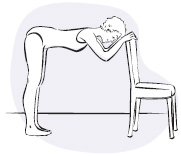 Stretches
muscles in the back of the thigh.
Stretches
muscles in the back of the thigh.
- Stand
behind chair, holding the back of it with both hands.
- Bend
forward from the hips (not waist), keeping back and
shoulders straight at all times.
- When
upper body is parallel to floor, hold position for 10
to 30 seconds. You should feel a stretch in the backs
of your thighs.
- Repeat
3 to 5 times.
Calves
 Stretches
lower leg muscles in two ways: with knee straight and
knee bent.
Stretches
lower leg muscles in two ways: with knee straight and
knee bent.
- Stand
with hands against wall, arms outstretched and elbows
straight.
- Keeping
your left knee slightly bent, toes of right foot slightly
turned inward, step back 1-2 feet with right leg, heel,and
foot flat on floor. You should feel a stretch in your
calf muscle, but you shouldn't feel uncomfortable. If
you don't feel a stretch, move your foot farther back
until you do.
- Hold
position for 10 to 30 seconds.
- Bend
knee of right leg, keep heel and foot flat on floor.
- Hold
position for another 10 to 30 seconds.
- Repeat
with left leg.
- Repeat
3 to 5 times for each leg.
Ankles
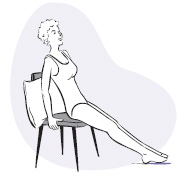 Stretches
front ankle muscles.
Stretches
front ankle muscles.
Summary:
- Remove
your shoes. Sit toward the front edge of a chair and
lean back, using pillows to support your back.
- Stretch
legs out in front of you.
- With
your heels still on the floor, bend ankles to point
feet toward you.
- Bend
ankles to point feet away from you.
- If
you don't feel the stretch, repeat with your feet slightly
off the floor.
- Hold
the position for 1 second.
- Repeat
3 to 5 times.
Triceps
Stretch
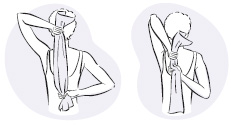 Stretches
muscles in back of upper arm.
Stretches
muscles in back of upper arm.
- Hold
one end of a towel in right hand.
- Raise
and bend right arm to drape towel down back. Keep your
right arm in this position, and continue holding onto
the towel.
- Reach
behind your lower back and grasp bottom end of towel
with left hand.
- Climb
left hand progressively higher up towel, which also
pulls your right arm down. Continue until your hands
touch, or as close to that as you can comfortably go.
- Reverse
positions.
- Repeat
each position 3 to 5 times.
Wrist
Stretch
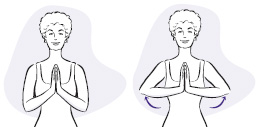 Stretches
wrist muscles.
Stretches
wrist muscles.
- Place
hands together, in praying position.
- Slowly
raise elbows so arms are parallel to floor, keeping
hands flat against each other.
- Hold
position for 10 to 30 seconds.
- Repeat
3 to 5 times.
Quadriceps
 Stretches
muscles in front of thighs.
Stretches
muscles in front of thighs.
- Lie
on side on the floor. Your hips should be lined up so
that one is directly above the other one.
- Rest
head on pillow or hand.
- Bend
knee that is on top.
- Reach
back and grab heel of that leg. If you can't reach your
heal with your hand, loop a belt over your foot and
hold belt ends.
- Gently
pull that leg until front of thigh stretches.
- Hold
position for 10 to 30 seconds.
- Reverse
position and repeat.
- Repeat
3 to 5 times on each side. If the back of your thigh
cramps during this exercise, stretch your leg and try
again, more slowly.
Double
Hip Rotation
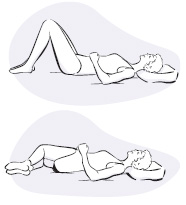 Stretches
outer muscles of hips and thighs. Don't do this
exercise if you have had a hip replacement, unless your
surgeon approves.
Stretches
outer muscles of hips and thighs. Don't do this
exercise if you have had a hip replacement, unless your
surgeon approves.
- Lie
on floor on your back, knees bent and feet flat on the
floor.
- Keep
shoulders on floor at all times.
- Keeping
knees bent and together, gently lower legs to one side
as far as possible without forcing them.
- Hold
position for 10 to 30 seconds.
- Return
legs to upright position.
- Repeat
toward other side.
- Repeat
3 to 5 times on each side.
Single
Hip Rotation
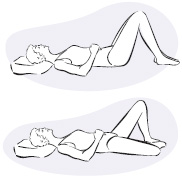 Stretches
muscles of pelvis and inner thigh. Don't do this exercise
if you have had a hip replacement, unless your surgeon
approves.
Stretches
muscles of pelvis and inner thigh. Don't do this exercise
if you have had a hip replacement, unless your surgeon
approves.
- Lie
on your back on floor, knees bent and feet flat on the
floor.
- Keep
shoulders on floor throughout exercise.
- Lower
one knee slowly to side, keeping the other leg and your
pelvis in place.
- Hold
position for 10 to 30 seconds.
- Bring
knee back up slowly.
- Repeat
with other knee.
- Repeat
3 to 5 times on each side.
Shoulder
Rotation
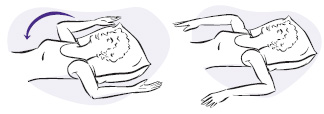 Stretches
shoulder muscles.
Stretches
shoulder muscles.
- Lie
flat on floor, pillow under head, legs straight. If
your back bothers you, place a rolled towel under your
knees.
- Stretch
arms straight out to side. Your shoulders and upper
arms will remain flat on the floor throughout this exercise.
- Bend
elbows so that your hands are pointing toward the ceiling.
Let your arms slowly roll backwards from the elbow.
Stop when you feel a stretch or slight discomfort, and
stop immediately if you feel a pinching sensation or
a sharp pain.
- Hold
position for 10 to 30 seconds.
- Slowly
raise your arms, still bent at the elbow, to point toward
the ceiling again. Then let your arms slowly roll forward,
remaining bent at the elbow, to point toward your hips.
Stop when you feel a stretch or slight discomfort.
- Hold
position for 10 to 30 seconds.
- Alternate
pointing above head, then toward ceiling, then toward
hips. Begin and end with pointing-above-head position.
- Repeat
3 to 5 times.
Neck
Rotation
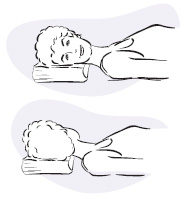 Stretches
neck muscles.
Stretches
neck muscles.
- Lie
on the floor with a phone book or other thick book under
your head.
- Slowly
turn head from side to side, holding position each time
for 10 to 30 seconds on each side. Your head should
not be tipped forward or backward, but should be in
a comfortable position. You can keep your knees bent
to keep your back comfortable during this exercise.
- Repeat
3 to 5 times.

